译林版选择性必修二Unit 1 高考真题练(含解析)
文档属性
| 名称 | 译林版选择性必修二Unit 1 高考真题练(含解析) | 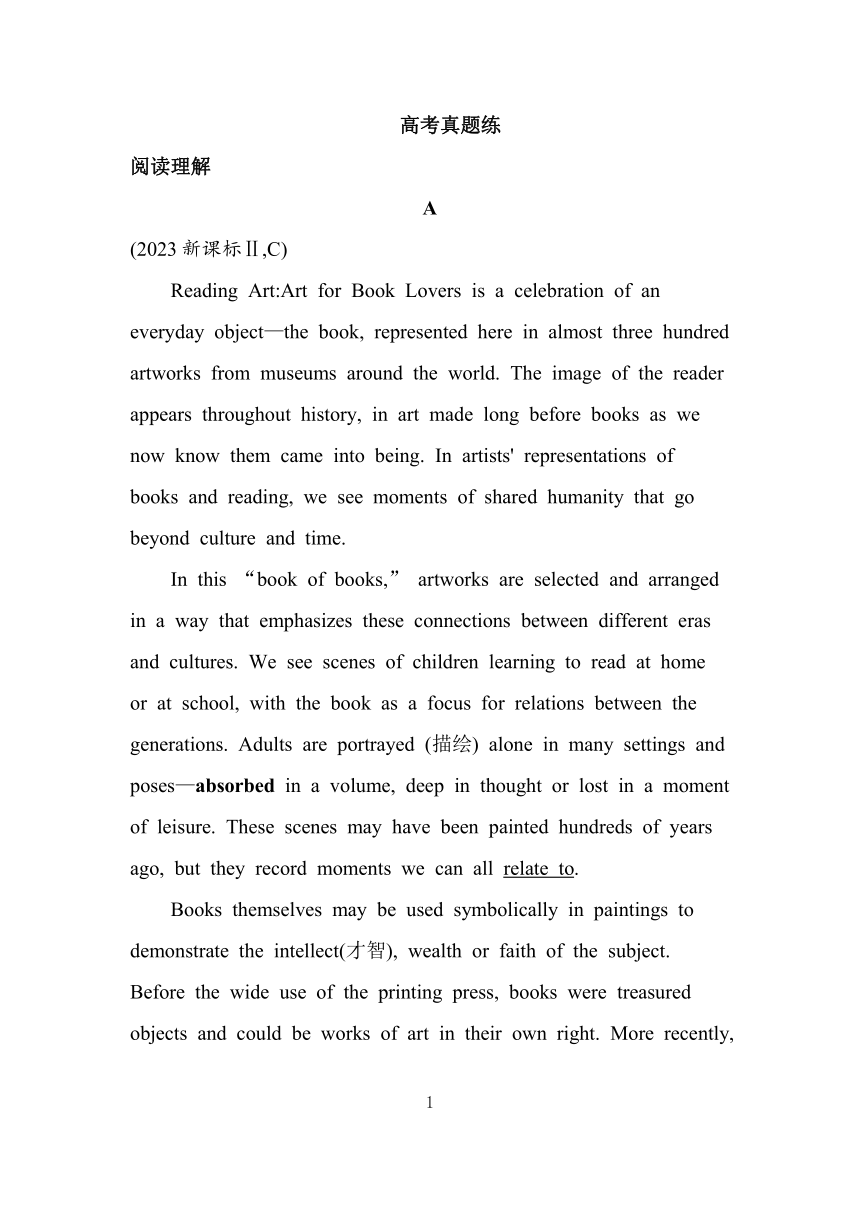 | |
| 格式 | docx | ||
| 文件大小 | 31.4KB | ||
| 资源类型 | 试卷 | ||
| 版本资源 | 牛津译林版(2019) | ||
| 科目 | 英语 | ||
| 更新时间 | 2025-07-09 18:26:47 | ||
图片预览

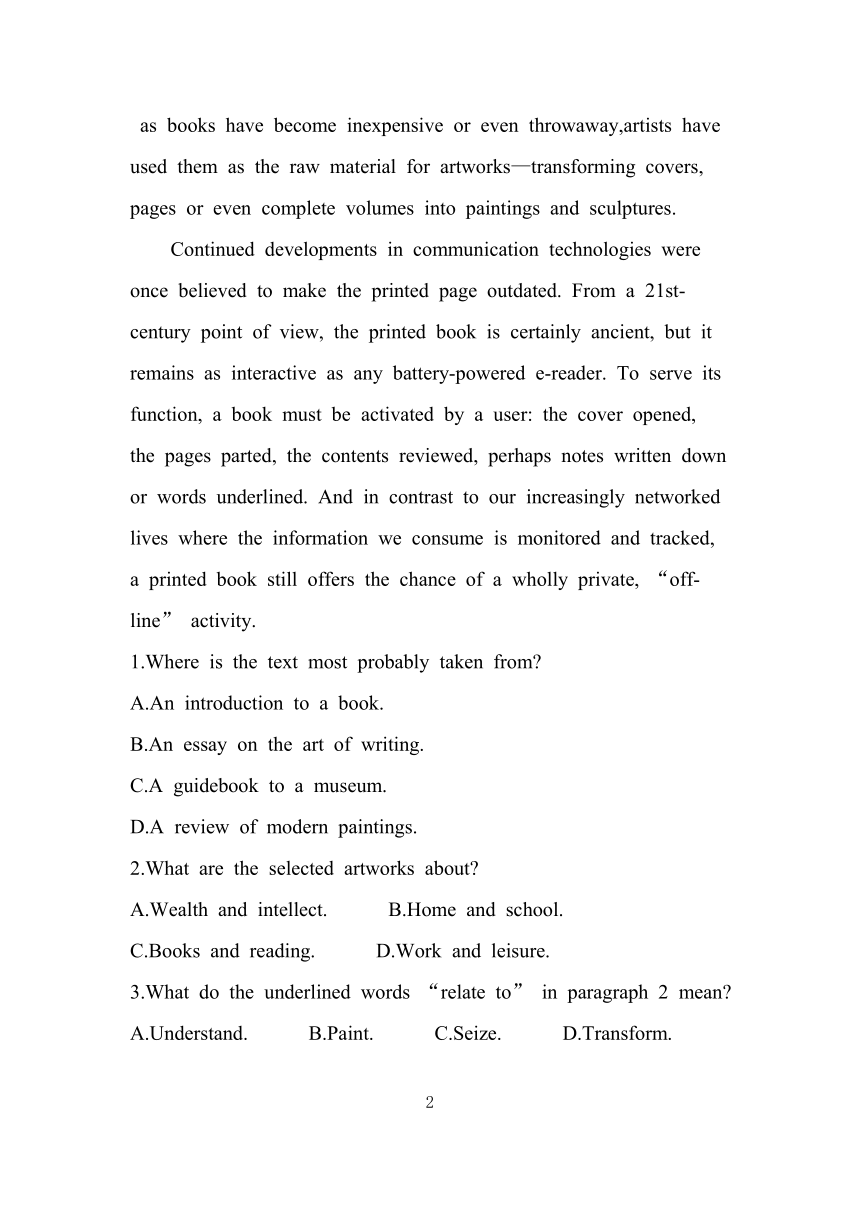
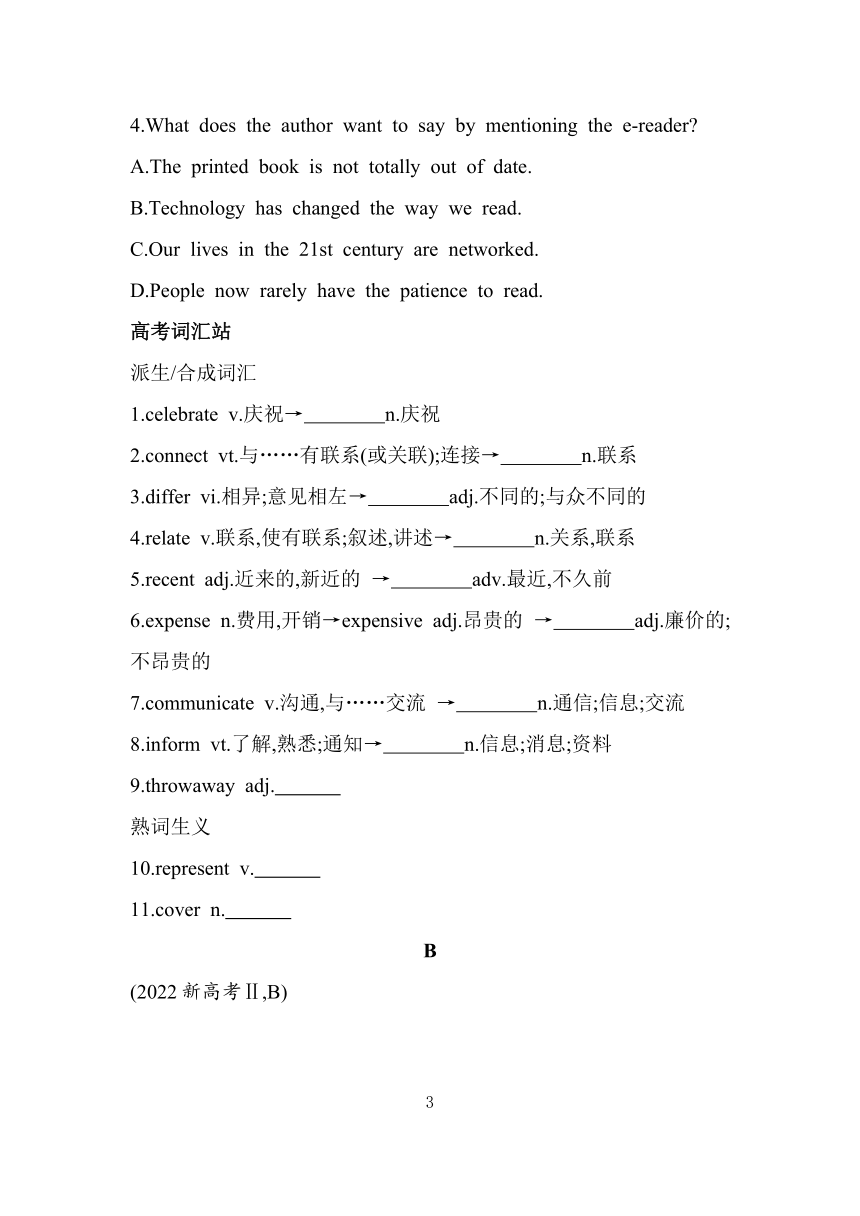
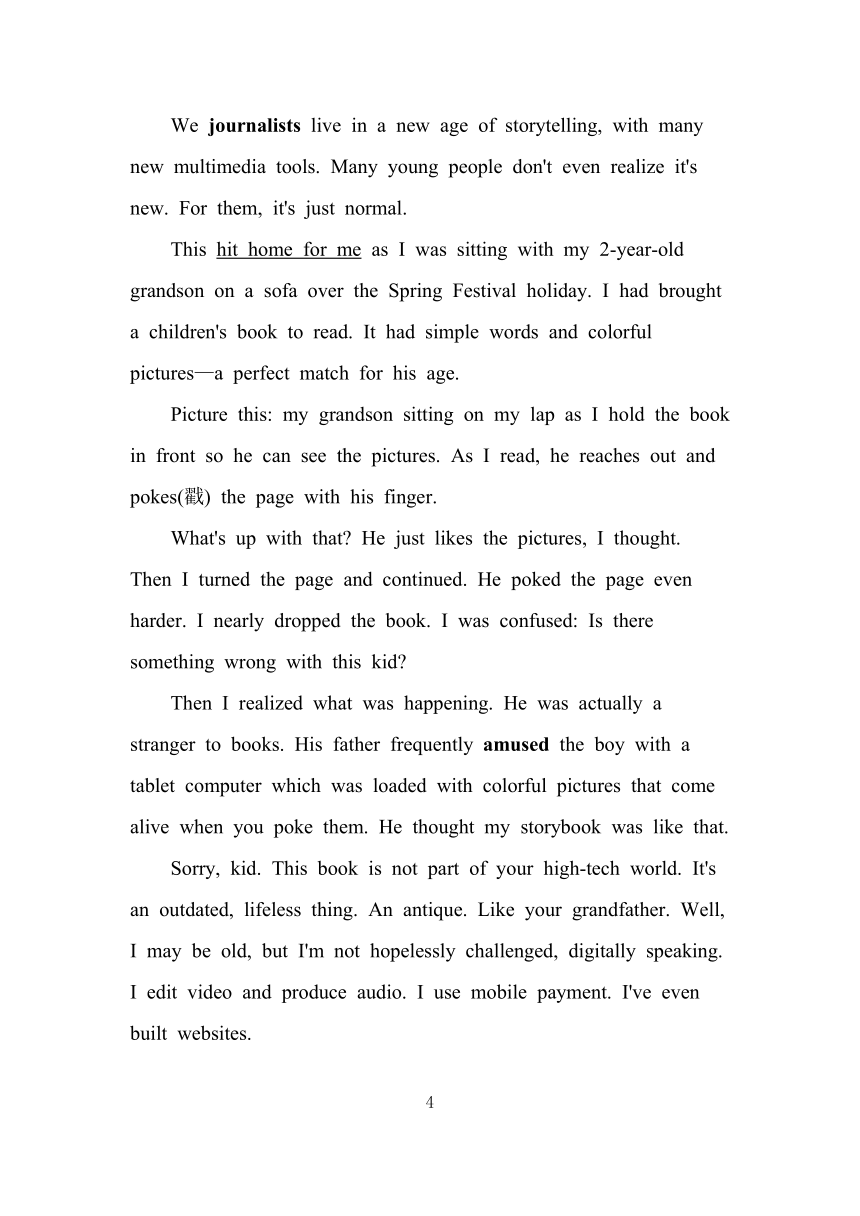
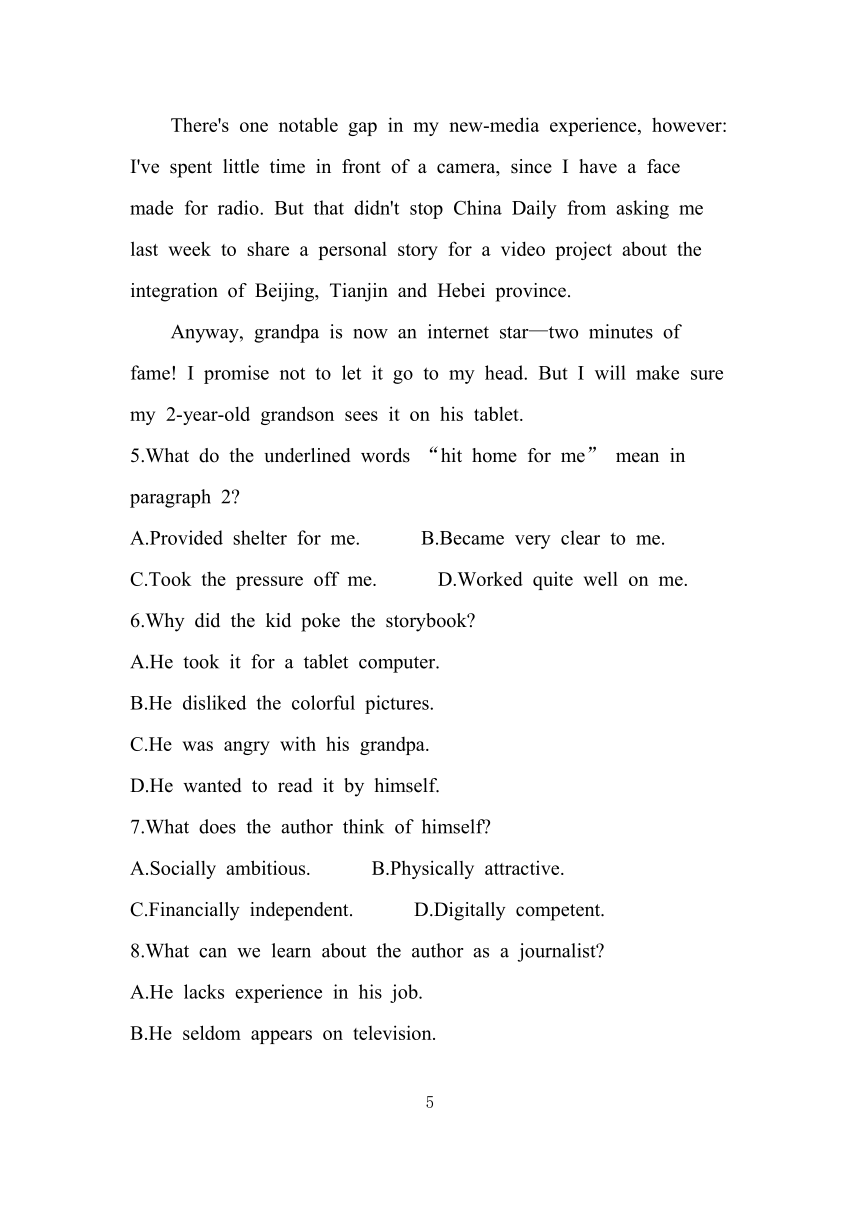
文档简介
高考真题练
阅读理解
A
(2023新课标Ⅱ,C)
Reading Art:Art for Book Lovers is a celebration of an everyday object—the book, represented here in almost three hundred artworks from museums around the world. The image of the reader appears throughout history, in art made long before books as we now know them came into being. In artists' representations of books and reading, we see moments of shared humanity that go beyond culture and time.
In this “book of books,” artworks are selected and arranged in a way that emphasizes these connections between different eras and cultures. We see scenes of children learning to read at home or at school, with the book as a focus for relations between the generations. Adults are portrayed (描绘) alone in many settings and poses—absorbed in a volume, deep in thought or lost in a moment of leisure. These scenes may have been painted hundreds of years ago, but they record moments we can all relate to.
Books themselves may be used symbolically in paintings to demonstrate the intellect(才智), wealth or faith of the subject. Before the wide use of the printing press, books were treasured objects and could be works of art in their own right. More recently, as books have become inexpensive or even throwaway,artists have used them as the raw material for artworks—transforming covers, pages or even complete volumes into paintings and sculptures.
Continued developments in communication technologies were once believed to make the printed page outdated. From a 21st-century point of view, the printed book is certainly ancient, but it remains as interactive as any battery-powered e-reader. To serve its function, a book must be activated by a user: the cover opened, the pages parted, the contents reviewed, perhaps notes written down or words underlined. And in contrast to our increasingly networked lives where the information we consume is monitored and tracked, a printed book still offers the chance of a wholly private, “off-line” activity.
1.Where is the text most probably taken from
A.An introduction to a book.
B.An essay on the art of writing.
C.A guidebook to a museum.
D.A review of modern paintings.
2.What are the selected artworks about
A.Wealth and intellect. B.Home and school.
C.Books and reading. D.Work and leisure.
3.What do the underlined words “relate to” in paragraph 2 mean
A.Understand. B.Paint. C.Seize. D.Transform.
4.What does the author want to say by mentioning the e-reader
A.The printed book is not totally out of date.
B.Technology has changed the way we read.
C.Our lives in the 21st century are networked.
D.People now rarely have the patience to read.
高考词汇站
派生/合成词汇
1.celebrate v.庆祝→ n.庆祝
2.connect vt.与……有联系(或关联);连接→ n.联系
3.differ vi.相异;意见相左→ adj.不同的;与众不同的
4.relate v.联系,使有联系;叙述,讲述→ n.关系,联系
5.recent adj.近来的,新近的 → adv.最近,不久前
6.expense n.费用,开销→expensive adj.昂贵的 → adj.廉价的;不昂贵的
7.communicate v.沟通,与……交流 → n.通信;信息;交流
8.inform vt.了解,熟悉;通知→ n.信息;消息;资料
9.throwaway adj.
熟词生义
10.represent v.
11.cover n.
B
(2022新高考Ⅱ,B)
We journalists live in a new age of storytelling, with many new multimedia tools. Many young people don't even realize it's new. For them, it's just normal.
This hit home for me as I was sitting with my 2-year-old grandson on a sofa over the Spring Festival holiday. I had brought a children's book to read. It had simple words and colorful pictures—a perfect match for his age.
Picture this: my grandson sitting on my lap as I hold the book in front so he can see the pictures. As I read, he reaches out and pokes(戳) the page with his finger.
What's up with that He just likes the pictures, I thought. Then I turned the page and continued. He poked the page even harder. I nearly dropped the book. I was confused: Is there something wrong with this kid
Then I realized what was happening. He was actually a stranger to books. His father frequently amused the boy with a tablet computer which was loaded with colorful pictures that come alive when you poke them. He thought my storybook was like that.
Sorry, kid. This book is not part of your high-tech world. It's an outdated, lifeless thing. An antique. Like your grandfather. Well, I may be old, but I'm not hopelessly challenged, digitally speaking. I edit video and produce audio. I use mobile payment. I've even built websites.
There's one notable gap in my new-media experience, however: I've spent little time in front of a camera, since I have a face made for radio. But that didn't stop China Daily from asking me last week to share a personal story for a video project about the integration of Beijing, Tianjin and Hebei province.
Anyway, grandpa is now an internet star—two minutes of fame! I promise not to let it go to my head. But I will make sure my 2-year-old grandson sees it on his tablet.
5.What do the underlined words “hit home for me” mean in paragraph 2
A.Provided shelter for me. B.Became very clear to me.
C.Took the pressure off me. D.Worked quite well on me.
6.Why did the kid poke the storybook
A.He took it for a tablet computer.
B.He disliked the colorful pictures.
C.He was angry with his grandpa.
D.He wanted to read it by himself.
7.What does the author think of himself
A.Socially ambitious. B.Physically attractive.
C.Financially independent. D.Digitally competent.
8.What can we learn about the author as a journalist
A.He lacks experience in his job.
B.He seldom appears on television.
C.He manages a video department.
D.He often interviews internet stars.
高考词汇站
派生/合成词汇
1.color n.颜色→ adj.多彩的
2.confuse vt.使迷惑;混淆→ adj.糊涂的,迷惑的;不清楚的,混乱的
3.strange adj.陌生的;不熟悉的→ n.陌生人
4.frequent adj.频繁的;经常发生的→ adv.频繁地;经常
5.hope v.希望→hopeless adj.无望的→ adv.无望地
6.storytelling n.
7.storybook n.
8.high-tech adj.
熟词生义
9.picture v.
答案与分层梯度式解析
Unit 1 The mass media
高考真题练
A
◎语篇解读 本文是一篇说明文。文章介绍了一本关于书籍的书,通过来自世界各地博物馆的艺术作品展现了读书场景在历史中的呈现和超越文化和时间的人性共同点。
1.A 推理判断题。根据第一段中“Reading Art: Art for Book Lovers is a celebration of an everyday object—the book, represented here in almost three hundred artworks from museums around the world.”可知,本文主要是对于《阅读艺术:书籍爱好者的艺术》这本书的介绍。故可推知,本文可能取自一本书的序言,故选A项。
2.C 细节理解题。根据第二段中“We see scenes of children learning to read at home or at school, with the book as a focus for relations between the generations. Adults are portrayed alone in many settings and poses—absorbed in a volume, deep in thought or lost in a moment of leisure.”可知,被选中的艺术作品是有关书籍和阅读的,故选C项。
3.A 词义猜测题。根据画线词前的“These scenes may have been painted hundreds of years ago, but they record moments we can all”可知,这些场景可能是数百年前绘制的,但它们记录了一些我们都能“relate to”的时刻。该句中的时刻指代上文中提到的“读书的场面”,它们所记录的读书的瞬间是能理解的。由此可推知,画线词relate to意为“理解”,故选A项。
4.A 推理判断题。本题题干意为:作者提到电子阅读器想说什么 根据最后一段中“Continued developments in communication technologies were once believed to make the printed page outdated. From a 21st-century point of view, the printed book is certainly ancient, but it remains as interactive as any battery-powered e-reader.”可推知,作者提到电子阅读器是为了说明印刷的书并没有完全过时,故选A项。
【高考词汇站】 1.celebration 2.connection 3.different
4.relation 5.recently 6.inexpensive 7.communication
8.information 9.用后丢弃的,一次性使用的 10.展示,描绘 11.(书刊的)封面,封皮
长难句
原句 More recently, as books have become inexpensive or even throwaway, artists have used them as the raw material for artworks—transforming covers, pages or even complete volumes into paintings and sculptures.
分析 本句为主从复合句,主句的主干为“artists have used them as the raw material for artworks”。as引导原因状语从句,主句后的现在分词短语作状语。
译文 最近,由于书籍变得廉价甚至是一次性的,艺术家们已经将书籍用作艺术品的原材料——将书籍的封面、内页甚至整本书变成绘画和雕塑作品。
B
◎语篇解读 本文是一篇记叙文。文章介绍了孩子对于新兴科技的接受程度以及老人为了适应科技做出的努力以及对自己的反思评价。
5.B 词义猜测题。文章第一段说很多年轻人认为现在的多媒体工具并不新鲜,而是很正常的;第二段中作者给小孙子读书的事使作者清晰地认识到了这一点。由此可知答案为B项。
6.A 细节理解题。根据文章第五段的“He was actually a stranger to books. His father frequently amused the boy with a tablet computer which was loaded with colorful pictures that come alive when you poke them. He thought my storybook was like that.”可知孩子对纸质书很陌生,他的父亲经常拿带有彩色图片的平板电脑逗他,当你戳图片的时候,图片变得生动起来。孩子以为作者的故事书也是那样的。所以答案为A项。
7.D 推理判断题。根据倒数第三段的“I edit video and produce audio. I use mobile payment. I've even built websites.”可知,作者不仅能编辑视频、制作音频、使用手机支付,还曾经建立过网站。D项:在数码方面有能力的。所以答案选D项。
8.B 推理判断题。根据倒数第二段的“I've spent little time in front of a camera”可知作者很少在镜头前出现,所以答案选B项。
【高考词汇站】 1.colorful 2.confused 3.stranger
4.frequently 5.hopelessly 6.讲故事 7.故事书 8.高科技的 9.想象,设想
长难句
原句 His father frequently amused the boy with a tablet computer which was loaded with colorful pictures that come alive when you poke them.
分析 本句是主从复合句。which引导定语从句,修饰先行词tablet computer;第二个定语从句由that引导,修饰pictures;when引导时间状语从句。
译文 他的父亲经常用布满彩色图片的平板电脑逗这个男孩笑,当你戳图片的时候,图片变得生动起来。
7
阅读理解
A
(2023新课标Ⅱ,C)
Reading Art:Art for Book Lovers is a celebration of an everyday object—the book, represented here in almost three hundred artworks from museums around the world. The image of the reader appears throughout history, in art made long before books as we now know them came into being. In artists' representations of books and reading, we see moments of shared humanity that go beyond culture and time.
In this “book of books,” artworks are selected and arranged in a way that emphasizes these connections between different eras and cultures. We see scenes of children learning to read at home or at school, with the book as a focus for relations between the generations. Adults are portrayed (描绘) alone in many settings and poses—absorbed in a volume, deep in thought or lost in a moment of leisure. These scenes may have been painted hundreds of years ago, but they record moments we can all relate to.
Books themselves may be used symbolically in paintings to demonstrate the intellect(才智), wealth or faith of the subject. Before the wide use of the printing press, books were treasured objects and could be works of art in their own right. More recently, as books have become inexpensive or even throwaway,artists have used them as the raw material for artworks—transforming covers, pages or even complete volumes into paintings and sculptures.
Continued developments in communication technologies were once believed to make the printed page outdated. From a 21st-century point of view, the printed book is certainly ancient, but it remains as interactive as any battery-powered e-reader. To serve its function, a book must be activated by a user: the cover opened, the pages parted, the contents reviewed, perhaps notes written down or words underlined. And in contrast to our increasingly networked lives where the information we consume is monitored and tracked, a printed book still offers the chance of a wholly private, “off-line” activity.
1.Where is the text most probably taken from
A.An introduction to a book.
B.An essay on the art of writing.
C.A guidebook to a museum.
D.A review of modern paintings.
2.What are the selected artworks about
A.Wealth and intellect. B.Home and school.
C.Books and reading. D.Work and leisure.
3.What do the underlined words “relate to” in paragraph 2 mean
A.Understand. B.Paint. C.Seize. D.Transform.
4.What does the author want to say by mentioning the e-reader
A.The printed book is not totally out of date.
B.Technology has changed the way we read.
C.Our lives in the 21st century are networked.
D.People now rarely have the patience to read.
高考词汇站
派生/合成词汇
1.celebrate v.庆祝→ n.庆祝
2.connect vt.与……有联系(或关联);连接→ n.联系
3.differ vi.相异;意见相左→ adj.不同的;与众不同的
4.relate v.联系,使有联系;叙述,讲述→ n.关系,联系
5.recent adj.近来的,新近的 → adv.最近,不久前
6.expense n.费用,开销→expensive adj.昂贵的 → adj.廉价的;不昂贵的
7.communicate v.沟通,与……交流 → n.通信;信息;交流
8.inform vt.了解,熟悉;通知→ n.信息;消息;资料
9.throwaway adj.
熟词生义
10.represent v.
11.cover n.
B
(2022新高考Ⅱ,B)
We journalists live in a new age of storytelling, with many new multimedia tools. Many young people don't even realize it's new. For them, it's just normal.
This hit home for me as I was sitting with my 2-year-old grandson on a sofa over the Spring Festival holiday. I had brought a children's book to read. It had simple words and colorful pictures—a perfect match for his age.
Picture this: my grandson sitting on my lap as I hold the book in front so he can see the pictures. As I read, he reaches out and pokes(戳) the page with his finger.
What's up with that He just likes the pictures, I thought. Then I turned the page and continued. He poked the page even harder. I nearly dropped the book. I was confused: Is there something wrong with this kid
Then I realized what was happening. He was actually a stranger to books. His father frequently amused the boy with a tablet computer which was loaded with colorful pictures that come alive when you poke them. He thought my storybook was like that.
Sorry, kid. This book is not part of your high-tech world. It's an outdated, lifeless thing. An antique. Like your grandfather. Well, I may be old, but I'm not hopelessly challenged, digitally speaking. I edit video and produce audio. I use mobile payment. I've even built websites.
There's one notable gap in my new-media experience, however: I've spent little time in front of a camera, since I have a face made for radio. But that didn't stop China Daily from asking me last week to share a personal story for a video project about the integration of Beijing, Tianjin and Hebei province.
Anyway, grandpa is now an internet star—two minutes of fame! I promise not to let it go to my head. But I will make sure my 2-year-old grandson sees it on his tablet.
5.What do the underlined words “hit home for me” mean in paragraph 2
A.Provided shelter for me. B.Became very clear to me.
C.Took the pressure off me. D.Worked quite well on me.
6.Why did the kid poke the storybook
A.He took it for a tablet computer.
B.He disliked the colorful pictures.
C.He was angry with his grandpa.
D.He wanted to read it by himself.
7.What does the author think of himself
A.Socially ambitious. B.Physically attractive.
C.Financially independent. D.Digitally competent.
8.What can we learn about the author as a journalist
A.He lacks experience in his job.
B.He seldom appears on television.
C.He manages a video department.
D.He often interviews internet stars.
高考词汇站
派生/合成词汇
1.color n.颜色→ adj.多彩的
2.confuse vt.使迷惑;混淆→ adj.糊涂的,迷惑的;不清楚的,混乱的
3.strange adj.陌生的;不熟悉的→ n.陌生人
4.frequent adj.频繁的;经常发生的→ adv.频繁地;经常
5.hope v.希望→hopeless adj.无望的→ adv.无望地
6.storytelling n.
7.storybook n.
8.high-tech adj.
熟词生义
9.picture v.
答案与分层梯度式解析
Unit 1 The mass media
高考真题练
A
◎语篇解读 本文是一篇说明文。文章介绍了一本关于书籍的书,通过来自世界各地博物馆的艺术作品展现了读书场景在历史中的呈现和超越文化和时间的人性共同点。
1.A 推理判断题。根据第一段中“Reading Art: Art for Book Lovers is a celebration of an everyday object—the book, represented here in almost three hundred artworks from museums around the world.”可知,本文主要是对于《阅读艺术:书籍爱好者的艺术》这本书的介绍。故可推知,本文可能取自一本书的序言,故选A项。
2.C 细节理解题。根据第二段中“We see scenes of children learning to read at home or at school, with the book as a focus for relations between the generations. Adults are portrayed alone in many settings and poses—absorbed in a volume, deep in thought or lost in a moment of leisure.”可知,被选中的艺术作品是有关书籍和阅读的,故选C项。
3.A 词义猜测题。根据画线词前的“These scenes may have been painted hundreds of years ago, but they record moments we can all”可知,这些场景可能是数百年前绘制的,但它们记录了一些我们都能“relate to”的时刻。该句中的时刻指代上文中提到的“读书的场面”,它们所记录的读书的瞬间是能理解的。由此可推知,画线词relate to意为“理解”,故选A项。
4.A 推理判断题。本题题干意为:作者提到电子阅读器想说什么 根据最后一段中“Continued developments in communication technologies were once believed to make the printed page outdated. From a 21st-century point of view, the printed book is certainly ancient, but it remains as interactive as any battery-powered e-reader.”可推知,作者提到电子阅读器是为了说明印刷的书并没有完全过时,故选A项。
【高考词汇站】 1.celebration 2.connection 3.different
4.relation 5.recently 6.inexpensive 7.communication
8.information 9.用后丢弃的,一次性使用的 10.展示,描绘 11.(书刊的)封面,封皮
长难句
原句 More recently, as books have become inexpensive or even throwaway, artists have used them as the raw material for artworks—transforming covers, pages or even complete volumes into paintings and sculptures.
分析 本句为主从复合句,主句的主干为“artists have used them as the raw material for artworks”。as引导原因状语从句,主句后的现在分词短语作状语。
译文 最近,由于书籍变得廉价甚至是一次性的,艺术家们已经将书籍用作艺术品的原材料——将书籍的封面、内页甚至整本书变成绘画和雕塑作品。
B
◎语篇解读 本文是一篇记叙文。文章介绍了孩子对于新兴科技的接受程度以及老人为了适应科技做出的努力以及对自己的反思评价。
5.B 词义猜测题。文章第一段说很多年轻人认为现在的多媒体工具并不新鲜,而是很正常的;第二段中作者给小孙子读书的事使作者清晰地认识到了这一点。由此可知答案为B项。
6.A 细节理解题。根据文章第五段的“He was actually a stranger to books. His father frequently amused the boy with a tablet computer which was loaded with colorful pictures that come alive when you poke them. He thought my storybook was like that.”可知孩子对纸质书很陌生,他的父亲经常拿带有彩色图片的平板电脑逗他,当你戳图片的时候,图片变得生动起来。孩子以为作者的故事书也是那样的。所以答案为A项。
7.D 推理判断题。根据倒数第三段的“I edit video and produce audio. I use mobile payment. I've even built websites.”可知,作者不仅能编辑视频、制作音频、使用手机支付,还曾经建立过网站。D项:在数码方面有能力的。所以答案选D项。
8.B 推理判断题。根据倒数第二段的“I've spent little time in front of a camera”可知作者很少在镜头前出现,所以答案选B项。
【高考词汇站】 1.colorful 2.confused 3.stranger
4.frequently 5.hopelessly 6.讲故事 7.故事书 8.高科技的 9.想象,设想
长难句
原句 His father frequently amused the boy with a tablet computer which was loaded with colorful pictures that come alive when you poke them.
分析 本句是主从复合句。which引导定语从句,修饰先行词tablet computer;第二个定语从句由that引导,修饰pictures;when引导时间状语从句。
译文 他的父亲经常用布满彩色图片的平板电脑逗这个男孩笑,当你戳图片的时候,图片变得生动起来。
7
同课章节目录
